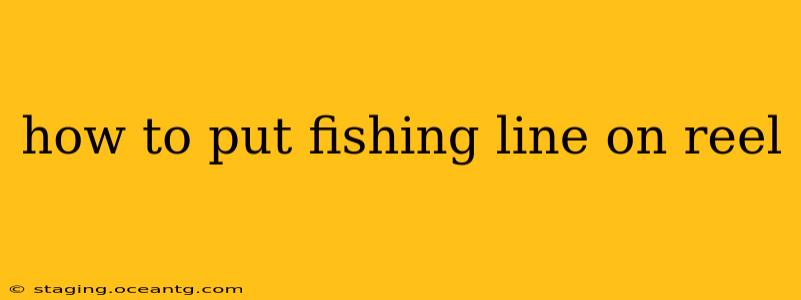Getting your fishing line correctly onto your reel is crucial for a successful fishing trip. A poorly spooled reel can lead to frustrating tangles, line breakage, and lost fish. This comprehensive guide will walk you through the process, ensuring your next fishing adventure is smooth sailing.
What You'll Need:
Before you begin, gather these essential items:
- Your fishing reel: Make sure it's clean and free of any debris.
- Spool of fishing line: Choose a line appropriate for your fishing style and target species.
- Line-tying tools: These might include scissors, a bobbin (optional, but helpful), and possibly a line-leveling tool (especially beneficial for spinning reels).
- Optional: A spool of backing line (for added capacity and to prevent the main line from slipping).
Step-by-Step Instructions for Spinning Reels:
1. Prepare the Reel:
- Open the bail (the metal arm that guides the line onto the spool).
- If using backing line, carefully add it to the reel, leaving about 6 inches of space before your main line. This prevents your main line from being damaged and ensures smooth operation.
2. Attach the Line:
- Thread the end of your fishing line through the hole at the end of the spool.
- Securely attach it to the spool. This is often done by tying a small overhand knot to the spool, ensuring this knot doesn't hinder the line's release. You should always have some extra line free.
3. Fill the Reel:
- Close the bail.
- Gently pull the line, guiding it onto the spool with even pressure. Don’t pull too hard or too fast, but maintain a constant tension.
- Keep an eye on the line's lay. You want it to lay flat and evenly across the reel spool, not piled up in one area.
- Use your thumb to gently control the speed and pressure, guiding the line into place, ensuring a smooth, level fill across the whole spool. For Spinning reels, the line should typically be wound onto the spool in a perpendicular manner, without overlapping layers.
4. Finishing Touches:
- Once the spool is full (leaving a bit of space at the top, usually about ¼ inch), trim the excess line.
- Close the bail.
- Use your hand or a line-leveling tool to check the line's distribution. If needed, make minor adjustments. A properly filled spool should have a near-perfectly level surface.
Step-by-Step Instructions for Baitcasting Reels:
The process for baitcasting reels is very similar, but with some key differences:
1. Prepare the Reel:
- Some baitcasting reels have a small lever or button to release the spool for line loading. Consult your reel's manual to see how it's done.
2. Attach the Line:
- The method for attaching the line to the spool is similar. Again, ensuring a firm knot without hindering the line's release is key.
3. Fill the Reel:
- With the spool free to rotate, carefully hold the line and slowly turn the handle, allowing the line to wind onto the spool. Maintain gentle, consistent pressure to avoid uneven spooling. You might need some practice to get the line to lay evenly on the spool without piling up or causing loops and knots.
4. Finishing Touches:
- Once the spool is nearly full (leaving the usual space), secure the line's end and trim the excess.
- Check the line lay; it should be evenly distributed.
How Tight Should the Line Be?
The line should be tight enough to prevent slippage, but not so tight that it causes the spool to become difficult to turn. You should be able to rotate the handle smoothly without undue resistance.
How Do I Know If My Reel Is Spooled Correctly?
A correctly spooled reel will have the line evenly distributed across the spool, forming neat, parallel layers. There shouldn't be any gaps or piles of line, and the line should not be excessively tight or loose.
What Happens If My Reel Isn't Spooled Correctly?
Incorrectly spooled line can lead to several problems, including:
- Line tangles: This is a common issue caused by uneven line distribution.
- Backlashes (baitcasting reels): Over-tight or uneven line can cause the line to pile up, creating backlashes.
- Line breakage: A poorly spooled reel can put extra stress on the line, increasing the chances of it breaking during a fight with a fish.
- Reduced casting distance: An unevenly spooled reel can affect casting accuracy and distance.
By following these steps and taking your time, you can ensure your fishing line is properly loaded onto your reel, leading to a more enjoyable and successful fishing experience. Remember to always consult your reel's specific instructions for any additional guidance.
